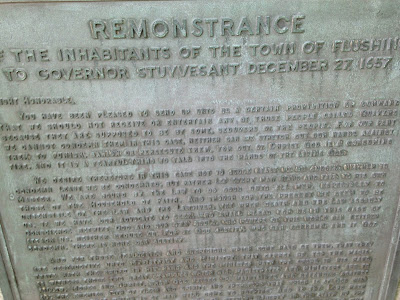The Flushing Remonstrance is a document setting forth complaints and grievances on the part of 30 townspeople practicing a forbidden sect of Quakerism, on December 27, 1657. Stuyvesant dispatched militia to Flushing where all signers were arrested. A monument to the Remonstrance can be found in the Bowne House garden.
Saturday, August 29, 2015
Bowne House, Flushing, Queens, New York, New York
The Bowne House, built in 1661, is a landmark shrine to religious freedom. John Bowne allowed certain outlawed sects of Quakerism to hold meetings in his house. With the arrival in 1657 of English Quakers. Governor Peter Stuyvesant issued a proclamation banning all religious observance but the official Dutch Reformed. Bowne was imprisoned, but was deported to Amsterdam where he successfully pleaded the cause of religious freedom before the Dutch West India Company.
 |
| 37-01 Bowne St. |
 |
| English oak, legendary tree of Robin Hood's Sherwood Forest |
 |
| George Fox, oaks monument, 1672 preacher |
Weeping Beech Park, Flushing, Queens, New York, New York
Tiny Weeping Beech Park on a 37th Ave. cul-de-sac is home of a most extraordinary tree grove. The tree was planted by Samuel Parsons in 1847, from a small shoot brought from Belgium. The Weeping Beech keeps company with the rare Golden Larch facing 37th Ave. and a tall Cedar of Lebanon in the playground. Parsons established a nursery in 1838, which later moved to Kissena Park, a keystone of Flushings horticultural industry.
In 1965, the Kingsland House, a house named for Joseph King in 1774, was moved on a flat-bed trailer from 155th St. and Northern Blvd. to its present site in Weeping Beech Park. The gambrel-roofed Dutch shingled house was once the home of the Murray family (until 1932) after whom the Murray Hill section of Flushing is named.
In 1965, the Kingsland House, a house named for Joseph King in 1774, was moved on a flat-bed trailer from 155th St. and Northern Blvd. to its present site in Weeping Beech Park. The gambrel-roofed Dutch shingled house was once the home of the Murray family (until 1932) after whom the Murray Hill section of Flushing is named.
 |
| Weeping Beech canopy |
 |
| Weeping Beech perimeter walk |
 |
| Kingsland House |
 |
| Cedar of Lebanon |
 |
| Cedar of Lebanon |
 |
| trunk, golden larch |
 |
| golden larch |
Tuesday, August 4, 2015
U.S. Post Office, Flushing, Queens, New York, New York
Neo-Georgian in design (1932), it is unassuming until you visit the muraled lobby. Architects were Dwight James Baum and William W. Knowles. The post office contains a massive mural by Vincent Aderente (Waldorf Astoria muralist) that wraps around the interior of the lobby. The mural depicts scenes from the early history of 12 communities served by the Flushing Post Office. The murals were funded by the Treasury Section of Fine Arts in 1933-34.
 |
| Main St. |
 |
| Elmhurst |
 |
| Woodside |
 |
| Maspeth |
 |
| Flushing |
 |
| Forest Hills |
 |
| Douglaston |
 |
| Little Neck |
 |
| Little Neck |
 |
| Whitestone |
 |
| Flushing |
 |
| Corona |
 |
| College Point |
 |
| Woodside |
 |
| Corona |
 |
| Maspeth |
 |
| Bayside |
Subscribe to:
Posts (Atom)
























